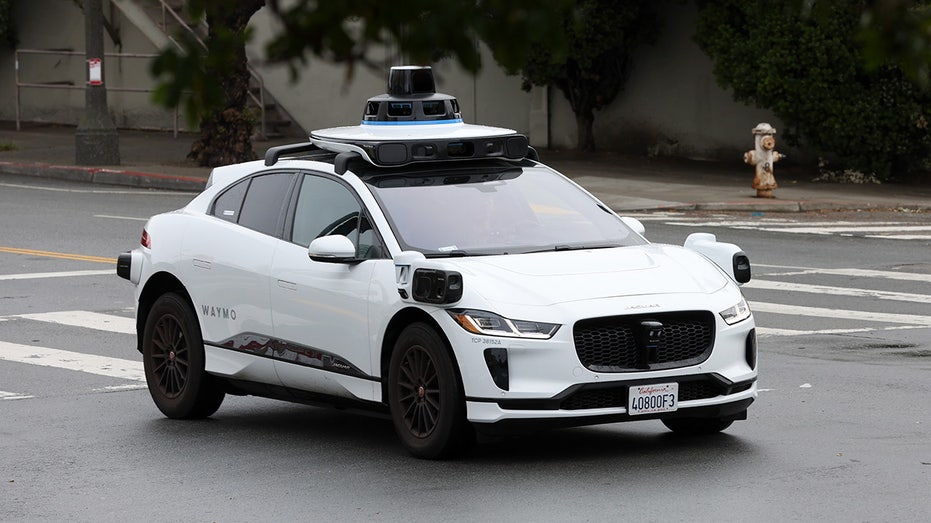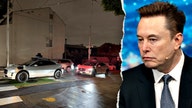Mercedes unveils fully autonomous vehicle
Mercedes-Benz USA CEO Dimitris Psillakis says drivers can watch videos while the vehicle takes over driving on 'The Claman Countdown.'
The advent of self-driving cars could lead to a number of changes to traffic laws down the road, including a possible fourth traffic signal, researchers say.
On top of the ubiquitous red, yellow and green, a white light could signal that autonomous vehicles are in charge of the intersection. Or the vehicles could possibly make signals irrelevant altogether.
North Carolina State University associate engineering professor Ali Hajbabaie is among those imagining the future of traffic lights.
"When we get to the intersection, we stop if it's red, and we go if it's green," Hajbabaie told The Associated Press, "but if the white light is active, you just follow the vehicle in front of you."
ELON MUSK'S FULL SELF-DRIVING (FSD) SOFTWARE A 'REALLY BIG DEAL'

This undated photo provided by the University of Michigan College of Engineering shows vehicles as they travel through the Old Woodward Avenue and East Maple signalized intersection, which was re-timed using the Optimized Signal as a Service in Birmi (Jeremy Little/University of Michigan College of Engineering via AP / AP Images)
An alternative could be red and green flashing lights, with no white light necessary.
The changes couldn’t come about until about half of all vehicles on the road are self-driving, he acknowledged, but University of Michigan civil engineering professor Henry Liu thinks it could be sooner than later.
WHAT IS ARTIFICIAL INTELLIGENCE (AI)?
"The pace of artificial intelligence progress is very fast, and I think it’s coming," he told AP.
University of Michigan researchers also landed a grant from the U.S. Department of Transportation via the bipartisan infrastructure law to test traffic light changes in real time using speed and location data from cars.

A Waymo autonomous vehicle travels along Masonic Avenue in San Francisco. (Justin Sullivan/Getty Images / Getty Images)
The university is conducting a pilot program in the Detroit suburb of Birmingham.
"The beauty of this is you don’t have to do anything to the infrastructure," Liu said, noting that Birmingham's traffic lights are on a fixed timer and don’t make adjustments for different traffic flows. "The data is not coming from the infrastructure. It’s coming from the car companies."
SELF-DRIVING TRACTORS ROLLING OUT IN CALIFORNIA COULD FUEL THE FUTURE OF FARMING
More than half of traffic lights nationwide don’t account for congestion or lighter-than-normal traffic like in the middle of the night.
Liu said although there are higher-tech solutions to monitoring traffic, they require cities to make complex and expensive upgrades.
The first "municipal traffic control system" appeared in Cleveland in 1914, according to Smithsonian Magazine. At first, there was just green and red, with the yellow light added a few years later.

Dr. Xingmin Wang, postdoctoral research fellow at the University of Michigan-Ann Arbor, shows a visualization of connected vehicle trajectory data insights that aid in the optimization of traffic signals. (Jeremy Little/University of Michigan College of Engineering via AP / Getty Images)
Since then, traffic lights haven’t changed much.
While fully autonomous vehicles are not yet on the market, companies like Tesla, Mercedes, GM and Ford are bridging the gap, along with Waymo, the autonomous rideshare service owned by Google’s parent company, Alphabet.
CLICK HERE TO READ MORE ON Gxstocks
"While it is good at this early stage of AV development that people are thinking creatively about how to facilitate the safe deployment of safe AVs, policymakers and infrastructure owners should be careful about jumping too soon on AV-specific investments that may turn out to be premature or even unnecessary," Waymo spokesperson Sandy Karp said in an email to The Associated Press.
Karp noted cars operate without a fourth light in select cities, including Los Angeles, Phoenix, Austin, Texas and San Francisco.




